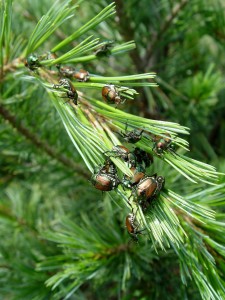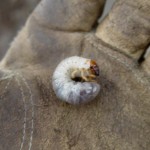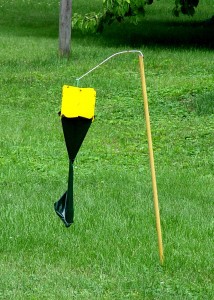Beetle Time
July 12th, 2011
We’re in the heart of Japanese-beetle season, and I don’t know about you, but I haven’t seen that bad of an infestation so far.
Some years this imported bug with the shiny coppery body swarms to Biblical proportions and shreds plants throughout the landscape. They’ll feast on 300 varieties – especially roses, grapes, cannas, cherry, crabapple and linden.
Other years, not so much.
Like most bugs, Japanese beetles run in cycles. One factor that limits them is dry soil when beetle eggs are trying to hatch into baby grubs in late summer. That’s right… in case you’re not aware, Japanese beetles start out as those fat, white, C-shaped grubs that kill off our lawns in early fall. They’re actually most damaging at that stage.
A second limiting factor is disease and predator activity. In the grub stage, populations are controlled by soil-borne disease, microscopic nematodes, birds, moles and skunks. In the adult stage, Japanese beetles are attacked by tiphia wasps, tachinid flies, birds (especially starlings), and of course, us.
One question I get a lot is whether it’s a good idea to use Japanese beetle traps. These are the hormone-scented hanging bags that draw beetles in and capture them.
You might’ve heard the saying that it’s best to buy traps for your neighbors rather than using them yourself. That’s absolutely true.
These traps do work, but if you’re the only one using them, you’ll be drawing in beetles from all over the neighborhood. You’ll find gazillions of them in the bag, but a gazillion more will be feeding on your roses – at least on the way to the trap.
The ideal situation would be for everyone around you to be drawing beetles their way and out of your yard.
The best “organic” way to control Japanese beetles is to pick them off your plants. Here’s a little-known secret: the best time to pick them is early in the morning when they don’t fly as well because of dew on their wings.
If you’re not a squisher, just drop the beetles into a jar of hot, soapy water.
Some people get rid of lots of beetles all at once by placing a sheet under infested plants and shaking the plants. Do it in the morning, and the beetles typically drop instead of flying away. Then you can stomp them or dump them.
Spraying is the classic control if damage is getting out of hand.
Neem oil is a natural spray that does a decent job of repelling beetles. VeggiePharm is a mint-oil spray that also works well.
Chemicals approved for beetle control include pyrethroids (bifenthrin, cyfluthrin, permethrin), carbaryl (Sevin) and malathion. The botanical spray rotenone also works.
The other control method is to go after the grub stage, which lots of homeowners do by applying imidacloprid (Merit) or halofenozide (Mach2) on their lawn early each summer. Those work very well, but I’m not a big fan of applying anything ahead of time that I may or may not need. Personally, if grubs wreck a section of my lawn, I put my money and effort into reseeding. Most years I see only little to no lawn damage from grubs.
Milky spore disease is touted as an organic and long-lasting product that can control Japanese beetles for more than 10 years. Field tests have been iffy, though, plus milky spore isn’t effective on chafer beetles, June beetles and Oriental beetles – three other grubs that also damage our lawns.
Usually a better organic control is nematodes, which are microscopic roundworms that feed on young grubs. You buy these live and apply around Labor Day to start feeding on the newly hatched grubs. A few garden centers sometimes carry them, or look for Heterorhabditis nematodes in catalogs and web sites (www.arbico-organics.com, www.buglogical.com, www.gardensalive.com).
Worthy Event
One of my favorite local gardening programs is the annual Summer Garden Experience that Penn State Extension runs the last Saturday of July at the Southeast Ag Research and Extension Center in Lancaster County.
This year’s sixth annual event happens July 30, from 9 a.m. to 2 p.m.
Author Ken Druse will be the keynote speaker, doing talks at 9 and 11 a.m. (“Secrets of the Garden Revealed” and “Plant Propagation”).
Lots of other talks and mini-seminars are on tap, and the highlight for me is always the guided tour of the new-flower trials that Alan Michael gives.
The place also will be crawling with Master Gardeners eager to answer your gardening questions, plus there will be wagon tours of the research farm and displays set up in the ever-growing Idea Gardens there.
Admission is a $10 per car parking fee. The research farm is located at 1446 Auction Road, Manheim, not far off the Esbenshade Road exit of Route 283.
Here’s a link for more details.










